Analysis of Technological Systems for Improving Drivers' Thermal Comfort
Funding: This study was supported by the College of Technology and Environment at London South Bank University (LSBU), London, United Kingdom.
ABSTRACT
This study investigates the integration of adaptive thermal comfort and indoor air quality (IAQ) systems in modern vehicles, emphasizing their impact on occupant well-being and automotive design innovation. The research examines state-of-the-art advancements in vehicle climate control technologies, from past developments to emerging smart thermal management solutions. It explores how artificial intelligence (AI), biometric monitoring, and energy-efficient climate control systems are transforming in-car comfort, ensuring dynamic adaptation to occupant needs while improving energy efficiency. A qualitative research methodology was adopted, incorporating explanatory and descriptive analysis. Data was collected through an extensive review of archival records, technical specifications, industry reports, and photographic sources to assess the evolution and effectiveness of thermal comfort technologies. The findings indicate that innovative HVAC and IAQ systems significantly enhance both driver and passenger comfort, leading to higher consumer demand for vehicles equipped with these technologies. Furthermore, the study highlights that future thermal comfort solutions will align with evolving user expectations, regulatory standards (such as ASHRAE-55 and EN-16798), and global sustainability goals. By bridging automotive engineering, human-centered design, and energy-efficient climate control, this study provides valuable insights into the next generation of intelligent vehicle comfort systems. The results offer a framework for optimizing thermal regulation strategies and demonstrate the potential of integrating adaptive climate control with AI-driven environmental sensing to enhance in-car experiences. Future research should focus on expanding AI-based climate personalization models and evaluating user perceptions of smart comfort technologies in real-world driving conditions.
Abbreviations
-
- ASHRAE
-
- American Society of Heating, Refrigerating, and Air-conditioning Engineers
-
- BS
-
- British Standards
-
- CIBSE
-
- Chartered Institution of Building Services Engineers
-
- EN
-
- European Norm
-
- GHG
-
- Greenhouse gas
-
- PMD
-
- Predicted Mean Vote
-
- PPD
-
- Predicted Percentage of Dissatisfied
-
- RH
-
- Relative humidity
-
- TPV
-
- Thermal preference votes
-
- TSV
-
- Thermal sensation votes
1 Introduction
The use of comfort systems technology in automobile production for vehicle drivers enables users to feel more comfortable and have a more enjoyable and safer journey in their vehicles [1]. The main scope of comfort systems is to provide customizable control and comfort to vehicle driving for heating and cooling purposes. Comfort is essential in the automobile industry because of considering acclimatization of indoor air quality during the journey. Nowadays, customers are seeking to buy vehicles in order to have high driving performance and comfortable interior spaces. To this extent, automobile manufacturers combine interior design with today's technology to design and produce virtual cockpits so that users can feel comfortable while driving. This comfort technology has led to increase demand on developing various software systems to control users' driving performance and their thermal comfort [2]. There is abundance of technological advancements available on the market, but the smart screen with indicators to control the speed and fuel consumption of the vehicle has been preferred mostly by the customers. Additionally, the speed control system to maintain the speed on the road, the ventilation and sunroof system to provide in-vehicle thermal comfort, and the heated electronic seats for ergonomic comfort can be given as frontier examples of comfort systems used in vehicle production today [3].
As in every sector in the world, automobile models are diversifying with the development of technology in the automobile industry [4]. Companies adapt to these ongoing competitive technologies and design their products with an understanding of quality, but many manufacturers also consider the development of adaptive thermal comfort systems for vehicles. This could result in changing consumer behavior while purchasing their vehicles. Many studies underline that the reliability of the vehicle, or the brand, appearance, mechanical features, price, and comfort are the most determinant factors at the time of identifying the most suitable vehicles [5]. It has to be noted that thermal comfort is an essential factor for drivers. One of the main reasons is that the outdoor environmental conditions have affected the users' driving experience and the poor air conditioning system may put drivers' safety in danger. In this regard, considering users' thermal comfort plays the utmost important role for designers. Additionally, manufacturers have understood the importance of this situation and have started to devote more time and budget to research on comfort technology in the production of vehicle models [6]. It can be seen that well-known brands in the automobile industry have developed and implemented different innovative ideas under the category of in-car comfort.
On the contrary, there is very little research undertaken to consider occupants' thermal comfort in vehicles in the past but today this situation has changed significantly, and many car manufacturers invested or offered grants to develop smart technologies both for considering occupants' thermal comfort and fuel efficiency of vehicles [7]. This is because of the use of technological developments in vehicle production, which allows users to perform more functions with less effort. It also provides ergonomic comfort in a position where users spend quality time during long journeys on the road [8]. For instance, a seat with suspension system for a driver who spends a long time traveling or the smart screen controls all the entertainment systems on the screen, fuel performance, and ventilation systems in the vehicle while driving are examples of how comfort is combined with technology in vehicle production.
Recent studies indicated that air quality, noise reduction, in-vehicle temperature, and wheel balancing systems are set to provide a comfortable journey for the drivers [9]. The purpose of the air quality system is to eliminate harmful gases and fuel emissions entering the vehicle from the outside. It should be noted that currently, vehicles are manufactured with the air quality monitor (QAM) system [10]. The operating logic of the QAM system is based on sensors installed in the air intake ducts of the Heating, Ventilation, and Air-Conditioning (HVAC) system. When these sensors detect a possible PM 2.5 gas or fuel emissions leakage, they send a signal to the fresh air inlet channel. The fresh air duct opens as a result of receiving a warning from this smart monitoring system (ibid). To this extent, this study focuses on exploring the available technologies on the market to highlight the significance of developing smart technologies to optimize drivers' thermal comfort (see Figure 1). Hence, this article investigates which systems and parts of the vehicle use comfort technology and explore efficiency of using smart technologies to optimize occupants' thermal comfort and improve the fuel efficiency of vehicles, as shown in Figure 1.

Figure 1 represents the key factors influencing passenger comfort in a vehicle or transportation system. This diagram highlights how these different elements interact to shape the overall experience of passengers. One of the primary influences on passenger comfort is environmental conditions, particularly air quality and temperature. Good air quality contributes to a more comfortable ride by reducing pollutants, odors, and excessive carbon dioxide levels inside the vehicle. This, in turn, impacts temperature regulation, as poor air circulation can lead to an increase in heat and humidity, causing discomfort. Maintaining optimal air quality through ventilation, filtration, and climate control systems is essential to ensuring a comfortable environment for passengers. Another critical set of factors includes sensory influences such as sound, noise, and vibrations. High levels of external or internal noise, including traffic sounds, engine noise, or mechanical disturbances, can reduce passenger comfort. Noise is also closely linked to vibrations, as excessive shaking from rough roads, engine movement, or structural resonance in the vehicle can cause discomfort. In addition to environmental and sensory factors, psychological and perceptual influences play a significant role in passenger comfort. Figure 1 highlights the connection between naturalness and apparent safety.
Fu et al. [11] indicated that the development of smart thermal comfort systems is the priority of manufacturers because of changes in consumer behavior regarding smart technology systems in their vehicles in the last decade. It must be highlighted that the Heat Balance Method (HBM) has been commonly accepted as a method used in adaptive thermal comfort systems to conduct more reliable experiments on indoor air quality assessment [12]. The purpose of this method is to determine the heating and cooling loads inside the vehicle. The net heat gain calculated with the thermal loads of the interior cabin is classified into nine different categories on the Likert scale thermal comfort assessment criteria. The values of these loads can have + or – loads configuration according to their heating or cooling functions [13].
- To examine the technological systems applicable to the automobile indoor air quality and explain these systems with frontier examples.
- To provide benchmarking criteria for comfort systems. For example, to evaluate the thermal comfort system within the American Society of Heating, Refrigerating and Air-Conditioning Engineers (ASHRAE) 55–2021 standard—Thermal Environmental Conditions for Human Occupancy.
- AI-driven Adaptive Climate Control: Unlike traditional heating, ventilation, and air conditioning (HVAC) systems, the study proposes a model that utilizes real-time data analytics from biometric sensors, vehicle telemetry, and environmental conditions to predict and adjust comfort settings dynamically.
- Integration of Ergonomic Smart Interfaces: The study incorporates haptic and voice-controlled interfaces that allow drivers to customize their comfort settings while maintaining focus on the road, enhancing both safety and user experience.
- Energy-Efficient Climate Optimization: The study assesses how predictive climate control models can reduce unnecessary energy consumption by adjusting airflow, temperature, and seat heating/cooling in real time based on occupant activity and physiological feedback.
This paper intends to propose a novel methodological approach in the use of driver's real experiences on the thermal comfort assessment. The originality of the research reported in this study lies in the epistemological approach of mixed methods adopted to capture and solve the complex problems related with driver's behavior and their thermal comfort considering the analysis of state-of-the-art technological advancements in the car industry. This is an attempt to achieve CO2 emissions reduction and save fuel energy use. The research effort within this paper has made several contributions to knowledge. The unique contribution is the investigation of the state-of-the-art technologies that incorporate driver's thermal comfort, safety and optimization of fuel use. The research in this study indicates that the reviewing of existing technologies could provide an evidence-based road map to increase the safety measures while considering driver's thermal comfort. Reviewing of pilot studies, especially the computational fluid dynamic tools, can provide subsequent information on the development of neutral adaptive thresholds considering driver's behavior. It enables to outline an effective scenario development regarding the complex intrinsic interrelationships that exist among the variations of driver's behavior.
The output within this study has the capability of demonstrating a clear understanding of driver's experience and the significant impact on assessing their thermal comfort. This can serve as a decision-making tool with the capability to incorporate acceptable standards by testing the effect different adaptive user's behavior. The output is also capable of developing a road map of driver's thermal comfort studies globally. Regarding analyze driver's optimum thermal comfort level, the findings suggest that the current Predicted Mean Vote (PMV) index is accurate enough while assessing variables related to occupants' behavior and hence no requires and further data mining process to extract the outliers in the applied statistical method. This could imply that the driver's Thermal Sensation Votes (TSVs) are capable of demonstrating reliable benchmarking criteria in conjunction with predicting the neutral adaptive thermal comfort thresholds in order to optimize driver's thermal comfort.
The contribution to knowledge is to outline the technical and design considerations for integrating adaptive thermal comfort systems into commercial vehicles, ensuring cost-effective and scalable solutions. By aligning the study findings with ASHRAE and ISO standards, the study provides a validated assessment methodology that manufacturers can adopt to enhance comfort, safety, and efficiency in vehicle cabins. This study explores how advancements in comfort technologies influence consumer preferences, providing strategic insights for automotive developers.
In summary, this article presents the strengths and weaknesses of all available technological advancements to acclimatize the indoor air quality of vehicles, which contributes to the knowledge in terms of adaptive thermal comfort, efficiency, and ergonomics for the automobile industry globally. Section 2 delineates the bibliometric review of previous scholars' work to identify knowledge gaps in adaptive thermal comfort. Section 3 describes the methodology chosen to explore state-of-the-art technologies for the development of brand-new vehicles. Section 4 demonstrates the descriptive analysis of smart technologies to address the main research question. Section 5 presents the outputs of the present study by identifying adaptive thermal comfort thresholds. Conclusions and recommendations are drawn in Section 6.
2 Previous Work
This section describes the history of comfort, physiological variables that affect the human body, the environment and the comfort indexes required by law, and lessons learned from these studies on how to conduct experimental analyses to assess both the occupants' thermal comfort preferences and sensations. It also outlines the various indexes, in particular the PMV indexes and the related measurement tools as provided by the regulations. Based on these considerations on the development of research in the field of comfort that includes the assessment of the social and cultural and tied to the occupants' behavior, in particular, the adaptive thermal comfort, and the simultaneous evaluation of comfort parameters through the investigation of occupants' interaction within the built environment and climate. This part of the research aims to analyze the sources written by expert academics and researchers about the technological comfort systems designed and used for the drivers' comfort in the vehicles' interior design.
This paper reviews understanding the drivers' thermal comfort by examining the significant impact of technological advancements in the car industry. Table 1 delineates the state-of-the-art experimental analysis conducted by previous scholars.
| References | A. Study location | C. Technological specifications | D. Primary aim of model | E. Methodology |
|---|---|---|---|---|
| Warey et al. [14] | Saarbrucken, Germany |
(i) 117 cars were unveiled at the IAA2007 car show. According to the data 46% of those were included touchscreens. (ii) Users interact with a small part of the in-car touchscreen. (iii) Three alternative mechanisms have been tried to facilitate interaction with in-vehicle touch screens namely, are standard, multifigure, and finger-specific input mechanisms. |
Analyzing the behavioral patterns of users while driving, comparing three different scrolling models for the in-car display, focusing on user perceptions in the automobile industry. |
(i) The user interface of the bright screen was determined, and a prototype application was developed for evaluation and testing. (ii) A prototype software interface was installed in a vehicle for recording drivers' behavioral patterns (iii) The faces of the drivers were recorded with a video camera to determine the amount of time the driver took their eyes off the road. |
| Yaqoob et al. [15] | Melbourne, Australia |
(i) In recent years, many technological developments have been related to develop driverless cars. Long journey times in these vehicles have led to research on improving users' comfort in vehicles. (ii) In order to improve drivers' comfort and reduce vibration, studies were carried out to develop a driver-vehicle interface (DVI) tool. |
Issues such as seat comfort and noise have been the subject of in-vehicle comfort improvement research. |
(i) In order to reduce the vertical vibration effects on a sample seat, an experimental setup was established by changing the suspension designs. (ii) Different users were asked to travel with and without music during their travels, and the results were compared as a result of the experiment to provide effective guidance for drivers' safety. |
| Cvok et al. [16] | Portsmouth, USA | (i) According to the statistics, more than 50% of accidents are caused by distractions inside the vehicle (such as a music player or smart screen). (ii) It is recommended that effective touch screen interface should be developed for the road safety. | Improving the design interface of music player, which is designed and implemented to increase in-car comfort. |
(i) To test the research results, a three-way multivariate mixed design test was applied to an equal number of men and women with a mean age of 27. (ii) Statistical analyses were evaluated with the NASA-TLX questionnaire. (iii) A vehicle simulator with a 64 × 110 cm music player was used to develop the experimental setup in order to measure drivers' behavioral experience with the simulator. |
2.1 Smart Technologies
The first resource reviewed for this purpose is an article by [14]. According to data from Warrey's article, 46% of the 117 vehicles introduced at the Internationale Automobil-Ausstellung (IAA) 2007 auto show have a smart touchscreen. Improving the in-car touchscreen technology has increased over time. Warrey et al. [14] have set up an experiment with three alternative mechanisms to test efficiency of this system. This experiment's primary purpose was to analyze drivers' interaction with the smart screen technology while driving and compare three different scrolling models designed for the experiment concurrently. In this experiment, a prototype mechanism whose interfaces are synchronized with different slide models was installed inside a prototype vehicle for the drivers' use. To obtain the data, drivers' behavioral activities were recorded with a video camera during the experiment. According to the data examined and analyzed as a result of this experiment, it was observed that 9 out of 15 users preferred finger-specific interaction instead of the conventional interaction with the touchscreen. In this regard, when the drivers' data were examined, the most obvious benefit was that the touchscreen smart screen positively affected the unrestricted use of the eyes. In addition, more than a third of drivers who used the smart screen synchronized with multi-finger gestures during their tests reported that they were not satisfied with this feature.
The second source is related to the development of the driver-vehicle interface (DVI) application designed to increase driver's thermal comfort and minimize distraction while driving on the road. According to this research, in-car entertainment systems, such as the multifunctional thermal comfort panel installed in the driving console should provide practical temperature adjustments to the users by considering the outdoor environmental conditions, users' clothing level insulation (clo) and metabolic activity rate (met). Yaqoob et al. [15] highlighted that the smart console systems also provide seat comfort and improvement efforts regarding the in-car noise problem.
In this study, seat comfort has been given priority to reduce the risk of vibrations while driving the vehicle on the motorway by the previous scholars. With regard to the solution for the road noise-related issues, subject respondents were asked to travel with or without music during their journey in the questionnaire survey. The findings revealed that almost 90% of the drivers considered musical travel through high-efficiency speakers that are aided to prevent the noise problem. In addition, the prototype seat model with adjustable suspensions designed for the experiment received positive user feedback.
Another pilot study was conducted by Cvok et al. [16]. According to Brusey et al. [17] research, more than 50% of road accidents are caused by distractions of drivers in the vehicle. In order to minimize this risk factor, it is recommended to have a maximum of three items in the list of smart screens and multimedia interfaces on the smart monitor in vehicles. This research highlighted the significance of efficient design of smart screen panel system in order to- reduce any hazardous effect of outdoor physical parameters and increase the driver's comfort in the vehicle while considering the danger of distraction for drivers. In order to prove this theory and find out how to design effective smart control systems, an equal number of male and female subjects with an average age of 27 were selected for the experimental analysis, and a three-way variable mixed test was applied to these subjects. The experimental setup used a 64 × 110 cm smart screen with multimedia content. As a result of the experiment, the data were evaluated and analyzed with the NASA-TLX questionnaire. Notably, the NASA task load index (NASA TLX) is a tool for measuring and conducting a subjective mental workload (MWL) of subject respondents to measure their behavioral activity and users' experience. According to the results, it was determined that 16 of the 18 participants made a mistake while trying to perform the command on the screen containing many options. The findings revealed that a more simplified smart screen and software interface could be effective rather than using a multi-item grid-shaped menu.
Another source on the development of effective software interfaces for smart screens found that customers pay attention to two key technical aspects, namely the vehicle's safety and adaptive thermal comfort options [18]. To highlight the importance of users' thermal comfort, Afzal et al.'s definitions of comfort were made in the research. Additionally, cockpit comfort in conventional vehicles was evaluated [19]. Comfort factors were determined by evaluating the vehicle's comfort because of the interaction between the sound level (e.g., engine noise) in the vehicle and the heat and mechanism in the vehicle's interior (ibid). The experiment of the examination was carried out in the cockpit assembly of a prototype vehicle with the participation of 35 drivers [20]. The vehicle's speed was set at a constant level of 40 km/h during the experiment; the temperature was set constant at 25°C, and the windows were closed throughout the experiment (ibid). The in situ experiments were conducted to gather accurate data for the study. First, in situ measurements were recorded with a noise measuring device during the journey. Second, the vehicle cockpit indoor air temperature was measured with an infrared-radiometer thermography device. This was followed by the data acquisition to conduct the statistical analysis accurately. It has to be noted that all these measured data were ranked according to the American Society of Automotive Engineers (ASAE) standards.
Zhou et al. [21] analyzed an effective artificial intelligence approach to identify user's thermal comfort. In this pilot study, it was found that where the temperature of the vehicle's cockpit has reached up to 35°C, it has led to affecting the physiological thermal comfort of occupants. This study also argued that the Heat Ventilation Air-Conditioning (HVAC) system should be used in the vehicle for the acclimatization of indoor air quality effectively. This study also revealed that 85% of the vehicles in today's automobile market have a primary heating and ventilation system in order to optimize drivers' thermal comfort (ibid). To prove the experimental study conducted by Zhou et al. [21], relevant theories, observations, and analyses of how the HVAC system affects thermal comfort were investigated. Furthermore, indoor air temperature, human activity, clothing insulation, and average radiant temperature factors were also examined. According to this experiment's results, it was found that the passengers' thermal comfort was negatively affected by those factors and further studies should consider both the users' clothing insulation level and metabolic activity in their longitudinal thermal comfort assessment studies.
2.2 Technical Analysis of Adaptive Thermal Comfort Systems
Thermal comfort in vehicles has traditionally relied on manually adjustable heating, ventilation, and air conditioning (HVAC) systems. However, modern advancements integrate AI-driven Adaptive Climate Control, which utilizes real-time data analytics from biometric sensors, vehicle telemetry, and environmental conditions to predict and adjust comfort settings dynamically. Unlike traditional systems that rely on fixed temperature settings, adaptive climate control employs predictive learning models to proactively modify airflow, temperature, and seat heating or cooling, ensuring personalized comfort for each occupant [22]. Furthermore, the study incorporates ergonomic smart interfaces, including haptic feedback and voice-controlled systems, allowing drivers to make comfort adjustments seamlessly while keeping their focus on the road. Research indicates that voice and gesture-based control interfaces significantly reduce cognitive load and improve safety during driving [18]. This smart integration optimizes comfort without distracting the driver, merging thermal regulation with user-friendly interactions.
Another key innovation is energy-efficient climate optimization. Conventional HVAC systems are energy-intensive and often inefficient. By integrating machine learning algorithms, the system can minimize unnecessary cooling and heating cycles based on real-time occupancy and external climate conditions. Studies have shown that intelligent climate control can reduce energy consumption by up to 20% compared to traditional vehicle HVAC systems [23], improving both thermal comfort and fuel efficiency. HVAC systems in modern vehicles integrate a network of sensors to monitor and adapt thermal conditions dynamically. These sensors include temperature, humidity, CO2, and infrared detectors, which continuously assess cabin conditions. The collected data is processed through an AI-driven control unit, which determines necessary adjustments to the airflow distribution and heating/cooling intensity [24]. For instance, if the sensors detect an increase in CO2 levels due to prolonged cabin occupancy, the system automatically increases fresh air intake while regulating temperature to maintain comfort. Similarly, infrared body temperature sensors can detect individual occupant temperatures, adjusting seat heating or ventilation accordingly. This dynamic control mechanism ensures that passengers experience consistent thermal comfort without manual intervention [11].
One of the most significant advancements in thermal comfort systems is the use of machine learning and predictive modeling. The AI-driven system learns from historical data, real-time sensor inputs, and user preferences to anticipate climate needs before discomfort occurs. For example, the model analyzes external weather conditions, solar radiation, and vehicle speed to predict potential heat buildup in the cabin and preemptively adjust cooling mechanisms [14]. A computational fluid dynamics (CFD) model is also integrated to simulate airflow distribution, ensuring even cooling and heating inside the vehicle. CFD simulations help optimize vent placement and fan speed, reducing localized discomfort such as cold feet and warm upper-body imbalances. By considering the thermal exchange properties of different cabin materials, the AI-driven system fine-tunes adjustments to prevent temperature variations that could impact passenger comfort [25].
A critical feature of modern thermal comfort systems is multi-zone climate control, which allows individual occupants to experience personalized temperature settings. Occupant detection systems use pressure-sensitive seating and facial recognition to identify passengers and automatically apply their preferred climate settings [26]. For instance, if the vehicle recognizes a frequent driver, it retrieves stored climate preferences and adjusts settings accordingly. Additionally, smart seat technology integrates micro-adjustable heating and cooling elements, which regulate temperature based on real-time biometric feedback. This ensures that each occupant experiences optimal thermal comfort without requiring manual input. Moreover, the incorporation of voice and gesture recognition enables drivers to modify climate settings intuitively, minimizing distractions and enhancing safety. A study by Yang et al. [10] found that voice-activated controls reduce driver reaction time by 30% compared to manual touchscreen interactions, significantly improving usability and road safety.
In summary, a multidisciplinary framework has been suggested that studies drivers' adaptive thermal comfort comprehensively and attempts to overcome the constraints to develop a roadmap in thermal comfort studies. The reason is that there is not any previously undertaken reliable review on understanding correlations between drivers' thermal comfort and their adaptive behavior. This has been proposed as a meaningful and accessible approach that could be adapted for the next-generation vehicle design. This is because it is important to review the extant previous studies on ergonomic comfort, state-of-the-art technologies, and drivers' thermal comfort.
3 Methodology
3.1 Adaptive Thermal Comfort
Thermal comfort is the cognitive and psychological behaviors of people living in a comfortable environment and the factors of weather conditions such as temperature and relative humidity [26]. The thermal comfort provided by the vehicle to the driver, on the other hand, similarly varies according to the interior temperature, humidity, and the car's color. Vehicle designers think that the thermal comfort of the driver should be kept at a high level despite the high temperature and humidity in the vehicle while the driver is traveling, and they develop their designs in this direction. For examples of these designs, the vehicle cabin thermal comfort simulation created by DTA Engineering with Simcenter Amenism software can be an example (DTA [27]). In this simulation, the basic models and the thermal model of the vehicle cabin are shown. This model also includes an HVAC system to help increase the driver's comfort in the vehicle. The HVAC system is a system that uses the principles of heat transfer and fluid mechanics to adjust the temperature in the vehicle and help improve the interior air quality. Today, more than 85% of the vehicles in the vehicle industry have an HVAC system [22]. The step-by-step development of methodology is shown in Figure 2 (see Figure 2).
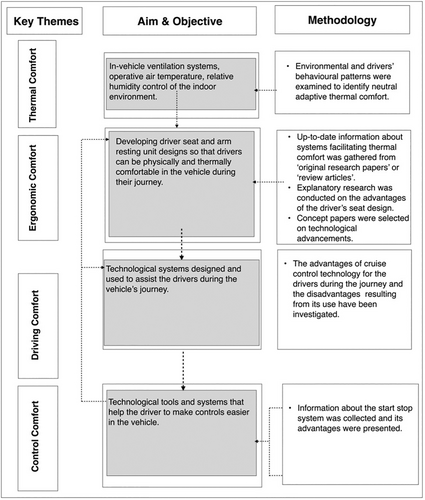
3.2 Data Acquisition and Assessment
This paper reviews the extant literature on the state-of-the-art studies on adaptive thermal comfort. Hence, adaptive thermal comfort and technological advancements in the car industry have been subjects of interest to improve indoor air quality while optimizing occupants' thermal comfort; therefore, this study aims to highlight the importance of the state-of-the-art technologies considering both ergonomic comfort and optimizing drivers' thermal comfort for the development of an adaptive thermal comfort approach globally (see Figure 3). To this extent, the Vos viewer software v1.6.18 and the Web of Science website were used on the keywords of ergonomic comfort, state-of-the-art technologies, and drivers' thermal comfort, revealing the key areas being investigated by researchers, as shown in Figure 3.

Data Source: https://www.vosviewer.co (accessed on 18 October 2024).
A structured bibliometric analysis was conducted using the Web of Science and VOS Viewer software to identify key trends in adaptive thermal comfort technologies. The study reviewed peer-reviewed articles published between 2015 and 2023, focusing on thermal comfort in vehicle cabins, HVAC efficiency, smart climate control, and air quality management. The search strategy included specific keywords such as ‘vehicle thermal comfort,’ ‘HVAC efficiency in cars,’ ‘adaptive climate control,’ and ‘energy-efficient car cooling systems.’ This approach ensured the selection of relevant studies that provided experimental validation, review analyses, or technological advancements in vehicle climate control. Studies were included if they were published in peer-reviewed journals, provided empirical evidence, or discussed adaptive thermal comfort models for vehicles. Studies unrelated to automotive applications, non-English articles, and those lacking experimental validation were excluded. The final dataset included 122 articles, classified into four main categories: (i) Smart HVAC control technologies, (ii) Energy-efficient climate adaptation, (iii) Thermal comfort perception and AI-based optimization, and (iv) Ergonomic enhancements in vehicle cabins.
To analyze research trends, co-occurrence maps were generated in VOS Viewer, identifying clusters of related studies and emerging research areas. This process provided insights into how adaptive comfort technologies have evolved, with a noticeable shift towards AI-driven climate control and personalized thermal comfort solutions in recent years. Additionally, a PRISMA-style flow diagram was used to visually depict the study selection process, highlighting the number of articles screened, included, and excluded at each stage. A regional analysis of bibliometric data revealed that research on adaptive HVAC systems is concentrated in Europe (35%), North America (28%), and Asia (25%), with limited studies from other regions. Studies conducted in Europe and North America emphasized energy-efficient HVAC systems and CO2 reduction, whereas Asian research focused more on smart cockpit interfaces and AI-based climate adaptation. The findings suggest that climate-specific HVAC technologies vary significantly, with cold-region models prioritizing heat retention and hot-region models focusing on advanced cooling mechanisms and solar-reflective materials. The review also examined technology adoption across different vehicle types. Internal combustion engine (ICE) vehicles have historically relied on conventional HVAC systems, whereas electric vehicles (EVs) are integrating energy-efficient climate control solutions to minimize battery drain. The transition to zonal climate control, where different sections of the cabin are individually managed, has emerged as a growing trend, enhancing thermal comfort and reducing energy consumption.
- −
Stage 1: The refrigerant gas is compressed to high pressure by the A/C compressor.
- −
Stage 2: This compressed refrigerant enters the condenser, where it turns into aliquid.
- −
Stage 3: In this stage, the refrigerant gas enters the dryer. Here, the gas is converted to a liquid by the moisture event.
- −
Stage 4: The refrigerant is pumped as a cold gas with the help of a liquid orifice pipe.
- −
Stage 5: The gaseous refrigerant flows with the aid of an evaporator. At this stage, the evaporator functions as a crossflow heat exchanger. Afterward, the air conditioner fan transfers the refrigerant gas into the cabin.
In this review paper, the data filtering method was applied to generate the most applicable original research papers and review articles within the scope of this study. In the VOS viewer interface, first, we applied the quick filters tool, and review article, early access, open access, and enriched cited references were selected. Second, we identified the citation topics Meso to extract the data from sustainability science and thermodynamics. Third, we selected the publication titles from Energy and Buildings, Building and Environment, Applied Energy, and Energies journals. Fourth, we selected the publishers from Elsevier, MDPI, and Taylor & Francis. Fifth, the publications selected the years between 2015–2022. Sixth, we selected Web of Science categories: Energy Fuels, Thermodynamics, Green Sustainable Science Technology, and Engineering Civil. After the selection of all these parameters, the data gathered from the VOS viewer and the data mining stage was applied to avoid any discrepancies in the dataset.
3.3 Ergonomy in Vehicles Comfort
The word ergonomics is a word that means comfort and comfort. These concepts are essential concepts for a driver traveling in a vehicle. Therefore, it is essential to provide ergonomic comfort in the vehicle. To give an example of the designs that need to be developed to provide this comfort, the driver's seat, which is the most contact place by the driver during the journey, or the arm resting mechanism designed to protect the arm comfort can be given as an example [18]. According to the research conducted by Automotive Seating Innovators in an article, it was reported that 10% of adult people experience low back pain and find ergonomic comfort in the vehicle critical [24]. An example is the lightweight seat design in the BMW I7, which was designed in collaboration between the TU Delft University of Technology and BMW and was introduced in Frankfurt in 2009 (ibid). This seat has been designed by examining the human body physiology during the design process and includes innovations such as a headrest, lumbar support, and massage system. According to this analyzed article, the main idea is that the heavier the seat is in the car's seat design, the more comfortable it is. The most used way of increasing this weight is the method of extra padding and cushioning inside the seat [28].
3.4 Driving Comfort
- It reduces the risk of accidents and increases the possibility of safe driving.
- It helps to save fuel with constant speed travel.
- It enables the driver to have a more comfortable journey by pressing the gas pedal less.
Another technological mechanism that helps to increase driving comfort is the lane tracking system. The lane tracking system is a technological system that generally works after 60 km/h with the help of a mechanism that analyzes the lane line data with the help of cameras located at specific points of the vehicle, such as mirrors and windshields. It sends them to the vehicle's brain. This system provides the user advantages such as safe driving and vehicle driving comfort. However, the system has advantages as well as disadvantages. Considering that this system is a technological system using sensor technology and its purpose is to read the lanes with the camera system, rough roads create a terrible scenario for this system.
The following image shows working with the cruise control system elements. In summary, the desired speed in the system is scanned by the speed sensors, and the margin of error is minimized and becomes the actual speed.
3.5 Control Comfort
Control comfort systems help the user in the vehicle make it easier to control various activities related to the vehicle while in the vehicle. Smart screen technology, which has become very common in the vehicle recently and is found in more than 46% of the vehicles in the automobile sector, and the start-stop system, where the driver can start and stop the vehicle with a single button, can be given as examples of these systems. Intelligent displays make it easier for drivers to control the vehicle by providing various conveniences such as multimedia control, speed, and fuel systems indicator observation to the driver during the journey [24]. Start-stop technology is another technological system designed to increase the comfort of drivers. The most significant advantages of this system for users are the reduction of fuel consumption of the vehicle, turning off the engine with a single button in areas with heavy traffic, and providing silence in the cabin since the sound of the fast engine will not come inside [12].
4 Data Analysis
4.1 Thermal Comfort
The purpose of this section of the report is to present the data obtained from the source research and analysis of the technological systems that will provide comfort to the user in the vehicle and to determine the advantages, disadvantages, and features of these systems within themselves. First, data analyses of thermal comfort determined from sources are presented. Then, after showing the data on ergonomic comfort, control systems and driving comfort were examined as technological systems under the same title, and data analysis and features were explained. While explaining thermal comfort in the Methodology part, it was said that DTA Engineering was working on the thermal comfort simulation of a vehicle. During the construction of the model, a black and a white vehicle was kept under the sun for 1 h, and when the result was analyzed, the following data graphics emerged.
Apart from this analysis, different keyword analyses related to the keyword thermal comfort were made with the Vos viewer application. The aim is to establish the link between the different keywords that appear and our main word and to analyze this link correctly. The data figure of thermal comfort with the help of Vos viewer is shown in Figure 4 (see Figure 4).
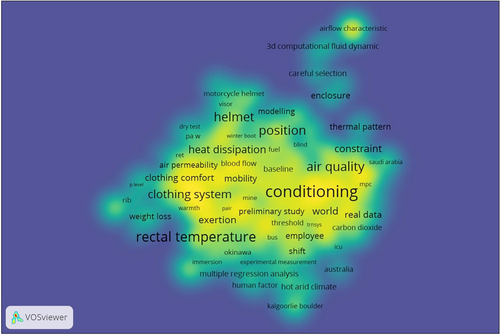
Data Source: https://www.vosviewer.com (accessed on 18 October 2024).
4.2 Ergonomic Comfort
In ergonomic comfort data analysis, keywords were analyzed with Vos viewer, the method used in thermal comfort data analysis (see Figure 5). The figure formed as a result of the analysis is shown in Figure 5.

Data Source: https://www.vosviewer.com (accessed on 18 October 2024).
When the above Vos viewer diagram about ergonomic comfort is examined, it has been determined that the image contains keywords related to ergonomic comfort. Examples of these words are disorder, pain, test, and shoulder. These words are the words that form the basis of ergonomic comfort. For example, in today's automobile industry, efforts to improve ergonomic comfort evaluate and test the pain and other discomforts experienced by the driver and passengers in hand and shoulder areas during travel. According to the conclusion drawn from this information, it has been determined that the words ‘shoulder,’ ‘test,’ and ‘pain’ are directly related to the ergonomic comfort topic.
The likelihood of certain conditions, such as musculoskeletal diseases (MSDs) and repetitive strain injuries, might be correlated with the ergonomic comfort in a vehicle (RSIs). These conditions can develop as a result of continuous or repetitive activities, as well as from poor posture or placement when driving. This table compares the technologies mentioned in the subject under three headings. Comparing titles and comparison results are presented in the table below (Table 2).
| Technologies | Technical specifications | Indoor air quality | Thermal comfort | Fuel efficiency |
|---|---|---|---|---|
| Air Conditioning System |
|
Improves interior air quality with advanced ventilation and filter systems. | Thermal comfort is provided with the new purification system and sensor systems that compare the passenger's in-cabin data. | There is no information about fuel saving in studies. |
|
The air pumped into the vehicle passes through two hybrid filters during the process, helping to improve interior air quality. | Thanks to the seat heating system of the system, maximum thermal comfort is provided for the driver inside the vehicle. | There is no information about fuel saving in studies. | |
| Cruise Control System |
|
The system has nothing to do with indoor air quality. | The system has nothing to do with thermal comfort. | With this system, the fuel efficiency of the vehicle increases as the braking and accelerating functions are performed systematically. |
| Smart Technologies |
|
Air cleaning filters work via touch and voice control with the help of the screen. | Control of cabin temperature, seat heater, and other concepts related to thermal comfort is done through this screen. |
The transition of the vehicle to the economical driving mode for fuel saving is done through this screen. Instant fuel consumption can be followed on the screen. |
4.3 Smart Technologies
Keywords formed in the data analysis of smart technologies are for the driving and control comfort headings described in the report. When we look at the words formed, words such as sensor, hardware and combination are seen. If we look at the systems used in driving and control comfort, we see that various software and sensor technologies are balanced and combined in these systems (see Figure 6). As a result, this is the information extracted from the diagram formed by the keywords of smart technologies is shown in Figure 6.

Data Source: https://www.vosviewer.com (accessed on 18 October 2024).
The diagram above contains keywords about smart technologies used in vehicles. Among these words, the famous words were a combination, sensor technology, ICT, and implication. When these words and the newly developed smart technologies in vehicles are examined, it has been determined that they are related.
According to this connection, a smart vehicle is created to increase the user's driving experience by combining the vehicle's sensor, comfort, and control-oriented technologies. This tool provides the user with information about the fuel consumption and performance of the vehicle while traveling or helps the user to make the journey more enjoyable with various multimedia activities.
In summary, in the data analysis section of the report, the sales figures collected from various sources related to the subject, market data, and informational texts to determine the advantages were examined. The results found are explained in the form of sub-headings in an explanatory manner. In addition to these sub-headings, a table of data analysis has been prepared as a summary of the chapter.
5 Discussion
5.1 Thermal Comfort
The primary purpose of this section is to compare the results of the information extracted and analyzed from different sources on the subject and subheadings and to write a discussion paragraph about these comparisons. The result data used while writing the discussion part are taken from the data analysis section, and comparisons are made accordingly.
The HVAC system in the vehicles was mentioned regarding technologies aimed at increasing thermal comfort. It can be said that the HVAC system is a perfect system for users as it facilitates both energy efficiency and cabin temperature and humidity customization options [29]. In addition to these, it is seen that it costs more than standard ventilation systems as a disadvantage. However, considering the increasing supply–demand relationship, the HVAC system offers designers a wide range of development opportunities. It is a successful system for increasing the thermal comfort of the user.
Technological developments in the thermal comfort field positively affect the global automobile market. The study is about these developments. Automobile thermal systems are expected to increase by 2.1% over the next 5 years [25]. In addition to this increase, the demand for new model cars will increase, and new options will be offered for the car market.
5.2 Ergonomic Comfort
Suppose we analyze the advantages and disadvantages from the information and data analysis about ergonomic comfort, according to the driver seat designers. In that case, the advantages of the development of the driver's seat are developments that will please the users. However, the disadvantages are the financial costs of the developments and the weight problem. The developments in ergonomic comfort could be more pronounced, as a cushioning process applied to the seat for additional comfort will adversely affect its weight, or an intelligent massage system applied to the seat will only attract the attention of curious and wealthy users.
The market report of the driver's seat with a massage mechanism, which was designed and developed with the aim of increasing ergonomic comfort, is shown in the image below. When the data in the image is examined, it is seen that this technology has increased sales by 5% in the global vehicle market.
5.3 Smart Technologies
Under this heading, the concepts of driving and control comfort examined in the report were evaluated together. Technological systems, which are applied inside the vehicle and designed to increase the user's comfort, have disadvantages and advantages. The systems are designed and applied to increase the users' comfort, but they cause the vehicle's internal parts to wear out more quickly. In addition, these systems are generally described as a luxury for many users and therefore pose a disadvantage in terms of cost [30]. However, besides all these, it is essential to consider the safe and comfortable driving experience that smart systems such as lane tracking systems, start-stop, and cruise control provide to drivers.
5.4 Thermal Comfort in Automobile Industry
Thermal comfort in an automobile refers to the temperature and air quality favorable to the occupants feeling comfortable and not experiencing discomfort or distress from heat or cold [31]. This can be influenced by factors like the outside temperature, the performance of the heating and air conditioning system, and the level of insulation in the automobile. Maintaining thermal comfort is critical for occupant comfort and well-being and their ability to concentrate and safely operate the vehicle [32].
- Assuring that the heating and air conditioning system is operational and capable of effectively heating or cooling the vehicle as needed.
- Using insulation materials limits heat transfer and maintains a more constant temperature within the car.
- Reduce the amount of solar radiation entering the vehicle and warming the inside by using sun blinds or window tinting.
- Using ventilation systems to bring in fresh air and aid in temperature regulation inside the vehicle.
- Maintaining a comfortable temperature by adjusting the thermostat or temperature settings.
As shown in Figure 7, the flow chart below shows the factors affecting thermal comfort in connection.
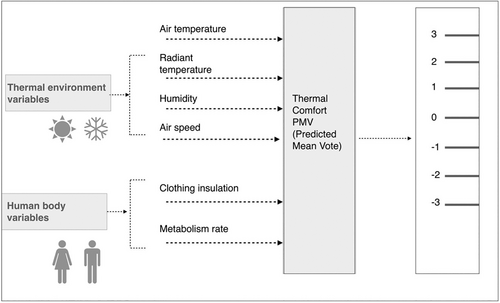
It is important to note that different people may have different comfort levels when it comes to temperature, so it may be necessary to adjust the settings [33].
- Close the windows and turn on the ventilation system to bring fresh air.
- Inside the vehicle, avoid smoking or using scented goods.
- To eliminate toxins from the air, use an air purifier.
- Clean and maintain the ventilation system regularly to ensure it works correctly and circulates fresh air.
Overall, maintaining thermal comfort in a vehicle entails managing the temperature and air quality inside the car to produce a comfortable and healthy environment for the passengers. Below, a general cabin model ANSYS with driver and passenger modeling, which will be used in the analysis of temperature and air quality management in an experiment to provide thermal comfort, is presented in Figure 8.
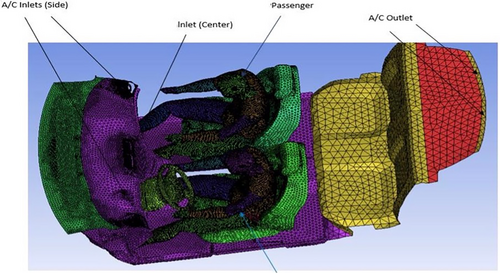
Figure 8 represents a Computational Fluid Dynamics (CFD) simulation of an automotive air conditioning (A/C) system, illustrating the airflow distribution within a vehicle cabin. The image is a meshed computational model, where different color-coded regions correspond to various components of the vehicle's HVAC system and interior layout. The A/C inlets (side and center) are designated as the entry points for conditioned air, while the A/C outlet at the rear indicates the exit point, ensuring efficient air circulation throughout the cabin. The simulation also incorporates passengers as solid structures, allowing an analysis of how airflow interacts with human occupants. This setup helps to evaluate thermal comfort by assessing how evenly conditioned air is distributed around passengers. Proper airflow distribution is crucial for preventing localized hot or cold spots, which can significantly impact passenger comfort. The inclusion of both side and center inlets suggests a system designed to optimize air mixing and minimize thermal discomfort.
While designing the cabin model, all the important factors that could affect the VTC were included in the design, including air conditioning inlet and outlet positions, front and rear window angles, and other ventilation sources (see Figure 8). The cabin model consists of front and rear sections as seen in Figure 9. In this cabin model used in the experiment, the interior volume of the rear section was measured as 2.276 m3 and 2.65 m2. According to the ASHRAE standards used due to the test conditions, it is recommended that the air velocities be 1 m/s [23]. Speed values higher than this speed can undesirably cool sensitive parts of the body such as the head, neck, and eyes of people. The figure below shows the thermal motions of the velocity streamlines in the chamber at the appropriate velocity [34].
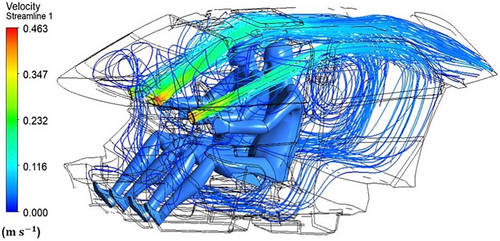
In Figure 9, the color-coded velocity scale on the left indicates the magnitude of airflow velocity in meters per second (m/s), ranging from 0.000 m/s (blue, low velocity) to 0.463 m/s (red, high velocity). The airflow streamlines are mapped throughout the cabin, showing how air is directed from the ventilation system, how it disperses, and where turbulence or recirculation zones occur. The red and yellow areas near the dashboard and steering wheel suggest higher airflow velocities, indicating direct A/C vent output. Meanwhile, the blue regions around the upper cabin and footwell areas indicate lower velocity zones, suggesting areas where air slows down and possibly stagnates. The two blue human figures in the diagram represent vehicle occupants, providing a reference for how airflow interacts with passengers. The streamlines around their upper bodies and hands suggest direct exposure to conditioned air, ensuring thermal comfort for the driver and front passenger. However, some air recirculation loops at the top and rear of the cabin indicate potential inefficiencies, where air movement might not be effectively reaching certain zones.
According to Figure 9, the size of the air velocity in the environment where the driver and passenger were in the car was 0.3 m/s. When the figure is examined in detail, a circulation zone has been detected in the rear seat area (see Figure 9). This is because the front seats block the air flow from the intake vents, thus deflecting the air towards the rear area. The passenger's legs diverted a portion of the air entering the front compartment's legroom space from the rear seat, as well as airflow from intake ports, towards the face region, which is regarded as unfavorable for passengers with breathing difficulties [35]. Air velocity refers to the speed at which air moves within a vehicle in the context of thermal comfort. The air velocity can influence heat transfer between the body and the surrounding environment, and hence thermal comfort.
Higher air velocities, in general, tend to improve heat transfer and can make a space feel cooler, whereas lower air velocities tend to limit heat transfer and can make a space feel warmer. However, extremely high or extremely low air velocities might cause discomfort or suffering [36]. It is often suggested to keep the air velocity in an automobile within a specified range to enhance thermal comfort. This range may vary according to the ambient temperature and the tastes of the occupants, although most individuals consider a moderate air velocity of 0.15 to 0.25 m per second to be acceptable.
Driver may alter the air velocity in your car by using the ventilation system and adjusting the position of the vents. It is also critical to check that the heating and air conditioning system is operational and capable of effectively heating or cooling the vehicle as needed. In automobile cabins, there is a factor that varies according to the air speed in the environment where the passenger is located. This factor is called the velocity field. The flow of air within a space, such as a car or a structure, is referred to as a velocity field. These air motions can influence heat transfer between the body and the surrounding environment, hence affecting thermal comfort. Natural convection, in which heated air rises and cooler air descends, or artificial devices such as fans or air conditioning units can produce velocity fields. It is critical to evaluate the velocity fields within a space and ensure that they are not excessively strong or too weak in order to enhance thermal comfort. The following figures show the different velocity field diagrams of similar car models.
The air flow rate value between the two schemes affects the ambient air temperature, and the ambient air temperature affects the comfort conditions of the driver. Temperature values between 21°C and 25.5°C have been determined as suitable for a thermally comfortable environment for the driver and passenger. Considering the similar temperature conditions for human body parts, the permitted vertical temperature differential between the human body's head and feet should be less than 3°C.
In the context of automotive thermal comfort, velocity fields refer to the movement of air within the car. These air motions can influence heat transfer between the body and the surrounding environment, hence influencing thermal comfort. It is often recommended to keep the velocity fields within a specified range to enhance thermal comfort in an automobile. This range may vary based on the ambient temperature and the occupants' preferences, although moderate velocity fields of 0.15 to 0.25 m per second are considered comfortable for most individuals. The ventilation system and the position of the vents of an automobile can be used to modify the velocity fields. It is also critical to check that the heating and air conditioning system is operational and capable of effectively heating or cooling the vehicle as needed.
It is worth mentioning that the shape and size of the space, the temperature difference, the humidity level, the existence of mechanical systems, and the presence of natural convection can all have an impact on velocity fields. You may help improve the velocity fields and preserve thermal comfort in the car by taking these aspects into account. Another factor affecting the thermal comfort in the cabin is the body temperature of the person in the cabin. When the values measured during the experiment are examined and analyzed, the air temperature on the left side of the passenger is approximately 23.2°C, while the air temperature at foot distance is 24°C. The equivalent temperature profile for the driver and passenger at various body areas is shown in Figure 10. The dotted lines show the thresholds for hot, cold, or neutral sensation for various body areas. The difference in head and foot temperatures between the driver and passenger was 2°C, which is within the range of pleasant temperatures.
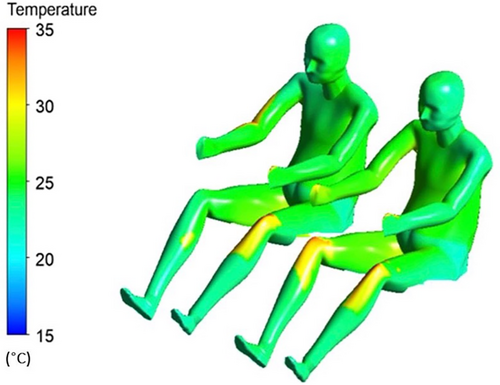
The heating and air conditioning systems in automobiles can both provide thermal comfort. The air conditioning system cools the air within the car and removes excess humidity, while the heating system heats the air (see Figure 10). A car's HVAC (Heating, Ventilation, and Air Conditioning) system oversees managing the temperature and humidity within the vehicle in order to give thermal comfort to the occupants. The HVAC system, which can be programmed to maintain a certain temperature or follow a specified temperature profile, can be managed by the driver or passengers via a control panel. The HVAC system also aids in the circulation of fresh air throughout the vehicle and the removal of any excess moisture or undesirable odors.
A vehicle's HVAC system normally consists of two cycles: heating and cooling. The heating cycle warms the air inside the car, whilst the cooling cycle cools the air inside the vehicle. A refrigerant is used in both cycles to transport heat from one site to another. The refrigerant collects heat from the outside air or the engine's cooling system and transfers it inside the car during the heating cycle. The refrigerant takes heat from the inside air and sends it outside the car during the cooling cycle. The HVAC system can be regulated by the driver or passengers via a control panel and configured to maintain a preset temperature or follow a schedule. The figures below show the diagram of the heating and cooling cycles that make up the HVAC system. The HX recovers heat produced by coolant flow inside the drive motor system during the heating cycle. When the car is started and the motor is cold, the coolant PTC heater next to the motor serves as an auxiliary heating system for quick heating [32].
Heating, ventilation, and air conditioning (HVAC) systems manage the temperature, humidity, and air quality. An HVAC system's heating and cooling cycle diagram shows how the system operates to maintain a comfortable indoor climate. The average HVAC system is made up of several essential parts, including:
- A thermostat regulates the HVAC system and adjusts the temperature setting.
- Depending on the season, an air handler or furnace is in charge of heating or cooling the air.
- An evaporator coil is employed in the cooling process to extract heat from the air.
- A condenser coil is employed in the cooling process to release heat from the refrigerant.
- A compressor circulates the refrigerant throughout the system by compressing it.
The thermostat notifies the air handler or furnace to begin heating the air during the heating cycle. Fuel, such as natural gas or oil, is burned in the furnace or air handler to provide heat. The hot air is subsequently distributed throughout the building's ducting. The air handler or furnace receives a signal from the thermostat to begin cooling the air during the cooling cycle. The compressor is activated by the air handler or furnace, pressurizing and moving the refrigerant through the evaporator coil. The refrigerant cools the air by absorbing heat from it. The cooled air is subsequently distributed throughout the building's ducting. After reaching the condenser coil, the heated refrigerant releases its heat and cools down once more, becoming ready for the subsequent cycle (ibid).
5.5 Indoor Air Quality Assessment
The thermal comfort issue explored in this part of the report is supported by the Centre for the Built Environment (CBE) Thermal Comfort Tool. The first graphic was created with the adaptive method option of ASHRAE-55, which is a tool option in accordance with American standards. This chart is presented in Figure 11.
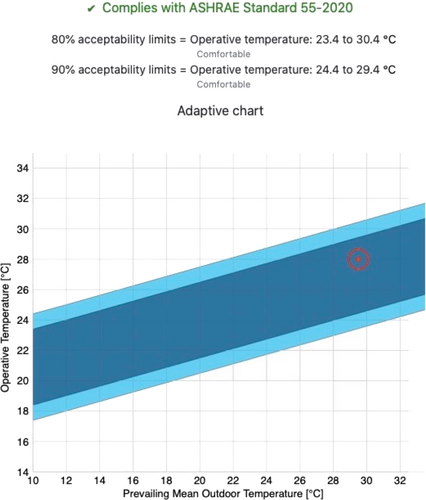
Data Source: https://comfort.cbe.berkeley.edu (accessed on 20/01/2023).
In this graph, the operative temperature is set to 28°C. Prevailing mean outdoor temperature option is determined as 30°C (see Figure 11). As a result, as read in the upper part of the graph, the temperature values were determined to be suitable for the comfort situation. The second graphic was created with the adaptive method option of EN-16798, which is a vehicle option in accordance with European standards. The generated graph is shown in Figure 12.
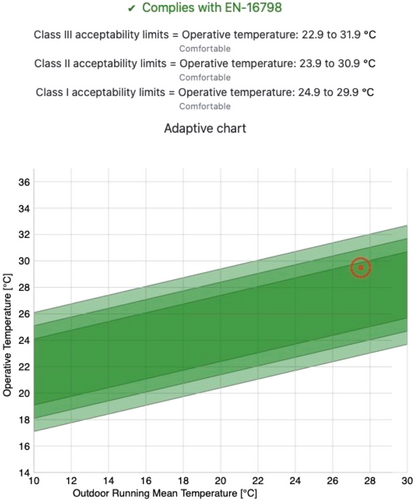
Data Source: https://comfort.cbe.berkeley.edu (accessed on 20/01/2023).
- Input 1
- Air temperature: 29°C.
- Mean radiant temperature: 25°C.
- Air speed: 0.7 m/s.
- Input 2
- Air temperature: 30°C.
- Mean radiant temperature: 26°C.
- Air speed: 0.8 m/s.
- Input 3
- Air temperature: 30.5°C.
- Mean radiant temperature: 26.5°C.
- Air speed: 0.6 m/s.
The graph created with these values and designed to compare the inputs is presented in Figure 13.
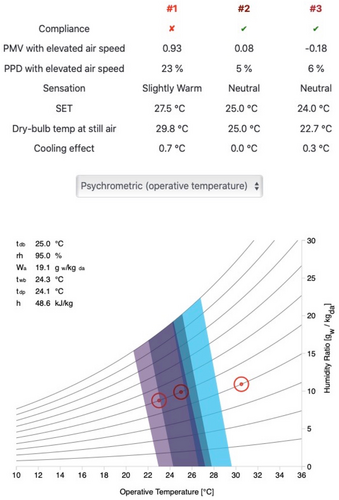
Data Source: https://comfort.cbe.berkeley.edu (accessed on 20/01/2023).
When the result of this graph is analyzed, it is observed that the 1st Input values give a slightly warm warning to the thermal comfort status, while the thermal comfort status is provided for the 2nd and 3rd Input values (see Figure 13). The fourth graphic was created with the Ranges tool option. While creating this graph, the graph was created by determining the clothing level, air speed, and metabolic rate values.
According to ASHRAE-55, the recommended thermal comfort range is between 20°C and 27°C, while EN-16798 expands this range to 18°C–28°C depending on outdoor climatic conditions. However, vehicles experience much wider temperature variations due to factors like solar heat gain through windows, cabin insulation properties, and localized air circulation patterns. Experimental studies indicate that typical vehicle cabin temperatures fluctuate between 18°C and 35°C, depending on ventilation efficiency and sun exposure. Modern adaptive climate systems must address these variations by dynamically modifying temperature zones in response to real-time sensor inputs and user preferences. AI-driven systems can adjust temperature settings preemptively, preventing discomfort caused by sudden heat buildup. Additionally, integrating heat-reflective coatings and phase-change materials in cabin design can help moderate temperature extremes, improving compliance with ASHRAE-55 and EN-16798 thresholds.
ASHRAE-55 recommends maintaining air velocity below 1 m/s to prevent unwanted drafts that cause discomfort. EN-16798 similarly suggests a maximum air velocity of 1.2 m/s for enclosed environments. However, vehicle airflow is highly variable due to multiple ventilation outlets, external wind interactions, and seat positioning. Computational Fluid Dynamics (CFD) simulations of vehicle cabins demonstrate that air velocity within different zones ranges from 0.3 m/s near seats to 1.5 m/s in high-ventilation areas, often exceeding standard comfort levels. To enhance comfort, vehicle HVAC systems use multi-zone air distribution and intelligent airflow modulation. By implementing occupant detection systems, airflow can be optimized based on individual thermal preferences, mitigating discomfort caused by localized air currents. The study recommends incorporating variable-speed fans and adjustable vent placement to ensure airflow is dynamically controlled, reducing thermal imbalances while maintaining alignment with ASHRAE-55 standards.
ASHRAE-55 and EN-16798 both specify that relative humidity (RH) should be maintained between 30% and 60% for optimal comfort. However, vehicle cabins experience significant humidity fluctuations due to factors such as occupant respiration, external weather conditions, and HVAC dehumidification cycles. Excessive humidity (> 70%) leads to condensation and discomfort, while low humidity (< 20%) can cause dry air discomfort.
5.6 Practical Implications
The major significant contribution stemming from this study would be the development of and reliable review of three concepts: ergonomy, technologies, and drivers' thermal comfort in order to outline a road map for the car industry. The first two key concepts can be used in future work in regard to assess drivers' thermal comfort in any type of experimental study considering drivers' habitual adaptive behavior and patterns. Additionally, the third concept involved novel statistical methods for validating the drivers' TSVs by considering longitudinal field studies and in situ experiments in actual laboratory conditions. This method could be useful while conducting the experiments in the climate chamber to identify neutral adaptive thermal comfort thresholds effectively. Nonetheless, it should be indicated that the opportunities and constraints of these methods were identified in the previous scholars' methodological framework and these findings could be generalized with the drivers' behavioral habits to identify discrepancies between the variables selected for the experimental analysis in thermal comfort studies.
Adaptive thermal comfort systems must be designed to integrate into both existing internal combustion engine (ICE) vehicles and next-generation electric vehicles (EVs). Unlike ICE vehicles, which generate significant waste heat that can be repurposed for cabin heating, EVs require energy-efficient climate control strategies to optimize battery life. For ICE vehicles, adaptive thermal comfort can be integrated through HVAC retrofitting, incorporating zonal climate control that directs airflow and temperature settings based on real-time occupant detection. Meanwhile, in EVs, implementing energy-efficient heat pumps and phase-change materials can significantly reduce battery drain while maintaining optimal comfort. Additionally, smart seat heating/cooling systems and personalized airflow control can further enhance passenger experience while improving energy efficiency in both ICE and EV models. Future vehicle designs should incorporate biometric monitoring systems, which allow for real-time adjustments based on occupant thermal perception. Such systems can be implemented using wearable devices or embedded sensors in vehicle seats and steering wheels. Furthermore, adaptive climate control systems should be developed with cloud-based AI algorithms, enabling vehicles to learn user preferences over time and optimize comfort settings accordingly.
While adaptive thermal comfort systems present numerous benefits, their implementation in real-world automotive design faces several key challenges. One of the primary challenges is cost constraints. Implementing advanced AI-driven climate control, biometric sensors, and heat pumps can significantly increase vehicle production costs, making it difficult for manufacturers to balance affordability with innovation. To address this, a modular approach can be adopted, where high-end vehicle models incorporate fully adaptive climate systems, while mid-range models offer selective smart climate features, such as personalized airflow zones or seat heating control.
Another major challenge is energy consumption, particularly in electric vehicles (EVs), where traditional HVAC systems can consume a significant percentage of battery power, reducing the overall driving range. One effective solution is the integration of waste heat recovery, thermoelectric materials, and intelligent air circulation strategies to optimize energy use. Additionally, AI-driven predictive models can minimize unnecessary cooling and heating cycles, ensuring that the climate system operates with maximum efficiency. Technical integration also poses a significant challenge, especially when retrofitting adaptive comfort systems into existing vehicle architectures, particularly older internal combustion engine (ICE) models. The lack of standardization across vehicle platforms can make it difficult to implement advanced thermal management technologies. A potential solution is to develop standardized modular climate control units that can be easily integrated into different vehicle models, simplifying adoption across multiple platforms.
Lastly, user acceptance and the learning curve associated with AI-controlled thermal comfort systems can be a barrier to widespread adoption. Many drivers may be hesitant to relinquish manual control over their vehicle's climate settings, particularly if the system does not immediately align with their comfort preferences. To address this, manufacturers should introduce a hybrid model, where users retain manual control while the AI system learns and adapts to their preferences over time. This gradual transition would help build trust in AI-driven climate management, increasing user adoption.
5.7 Recommendations for Industry Standards
The integration of adaptive thermal comfort systems in modern vehicles must align with industry standards and regulatory frameworks, particularly those concerning energy efficiency and environmental sustainability. Organizations such as the American Society of Heating, Refrigerating and Air-Conditioning Engineers (ASHRAE-55) and EN-16798 establish thermal comfort benchmarks for human occupancy, which can serve as a reference for optimizing vehicle HVAC systems. From an energy efficiency perspective, current regulations require manufacturers to implement low-energy climate control solutions, particularly for electric vehicles (EVs), where HVAC-related energy consumption can reduce driving range by up to 30%. Technologies such as heat pumps, zonal climate control, and AI-driven thermal optimization align with these energy efficiency goals by reducing overall power consumption while maintaining passenger comfort.
Regarding environmental impact, automotive climate control systems are subject to CO2 emission regulations, particularly in regions enforcing strict fuel efficiency standards (e.g., EU's WLTP and US CAFE standards). By integrating smart climate control systems that minimize energy waste, manufacturers can reduce CO2 emissions and comply with stringent environmental policies. Additionally, the transition towards non-toxic, low-GWP (Global Warming Potential) refrigerants in automotive HVAC systems further enhances sustainability efforts. While these adaptive comfort solutions present promising advancements, their widespread adoption depends on overcoming technical, regulatory, and economic challenges. Future research should focus on harmonizing industry standards with the development of energy-efficient and environmentally responsible climate control technologies to ensure compliance with global sustainability goals.
6 Conclusions
This research aimed to examine the features, advantages, and disadvantages of vehicle comfort technologies and share the results with the reader. Research has been done from various articles about technologies designed to increase driver comfort, and the data has been analyzed. The data obtained from the results with different graphs and tables from different sources were supported. These supported and extracted data and comfort types were compared according to their advantages and disadvantages in the discussion. According to the findings, while some comfort designs are essential and worth using for human health and safety, some designs fall into the luxury category and appeal to customers who do not have financial problems. These technological systems increase driver comfort and benefit the user in many areas. For example, according to research results, the start-stop system benefits the user by helping to save fuel. When these implications are examined, many new and advanced technological systems will be designed and used in the future to respond to the demands of the manufacturers in line with the increasing demands of the user in the automobile industry.
In the last part of the study, detailed system and data analysis of thermal comfort, which is one of the comfort systems used in vehicles, has been made. The data found in these analyses were supported by various tools. As a result of the data found and supported, how the thermal comfort is integrated into the vehicles, how the system works, its advantages and disadvantages have been learned.
As vehicle manufacturers continue to innovate, future thermal comfort solutions should focus on energy-efficient HVAC designs, improved airflow distribution, and AI-driven adaptive climate control. Additionally, longitudinal studies on user adaptation to AI-based climate systems and further computational modeling of in-vehicle thermal conditions are necessary to optimize occupant experiences. By leveraging advancements in smart sensing, thermal regulation, and ergonomic design, the automotive industry can redefine the next generation of intelligent vehicle climate systems. Ultimately, this research provides a comprehensive understanding of the impact of advanced comfort technologies on vehicle thermal environments, offering valuable insights for automotive engineers, designers, and researchers seeking to optimize in-car thermal comfort while maintaining energy efficiency and environmental sustainability. Future research should expand on real-world testing and user experience evaluations to further refine adaptive comfort systems for diverse vehicle models and climatic conditions.
Nomenclature
-
- °C
-
- Celsius
-
- p
-
- Significant level
-
- r
-
- Number of elementary effects per parameter
-
- Ta
-
- Indoor air temperature
-
- To
-
- Outdoor air temperature
Author Contributions
Mert Duzgun: conceptualization, writing – original draft, methodology. Bertug Ozarisoy: conceptualization, investigation, funding acquisition, writing – original draft, writing – review and editing, visualization, validation, methodology, formal analysis, software, supervision, project administration, resources. Hasim Altan: conceptualization, writing – review and editing, supervision, methodology. Sam Moshaver: supervision, writing – review and editing, conceptualization, methodology, validation.
Acknowledgments
The authors would like to acknowledge the School of the Built Environment and Architecture at the London South Bank University (LSBU), London, United Kingdom.
Ethics Statement
Ethical review and approval were waived for the study.
Conflicts of Interest
The authors declare no conflicts of interest.
Open Research
Data Availability Statement
The data that support the findings of this study are available on request from the corresponding author. The data are not publicly available due to privacy or ethical restrictions.




